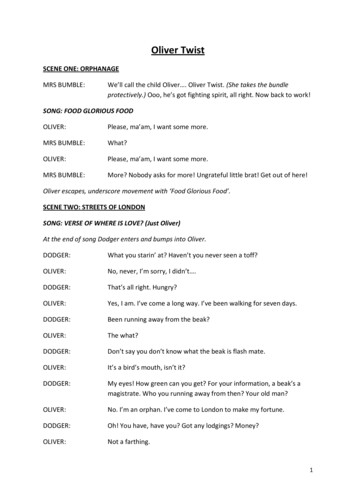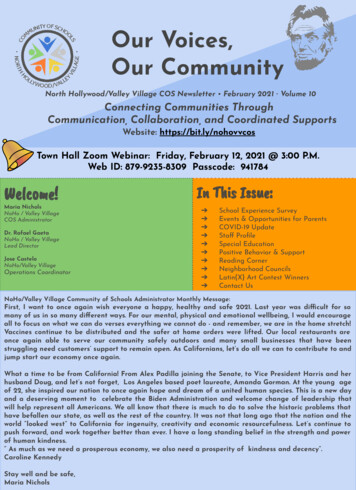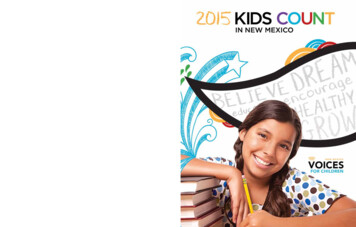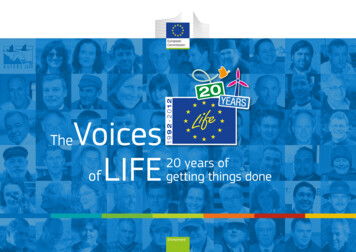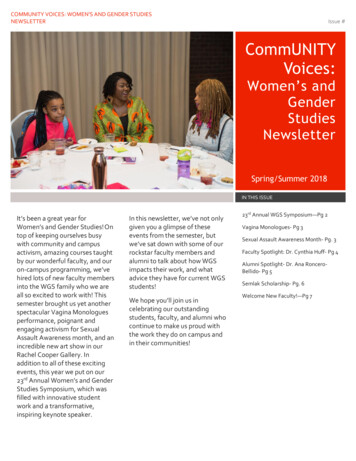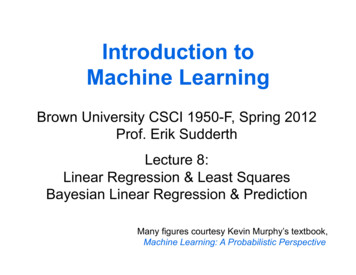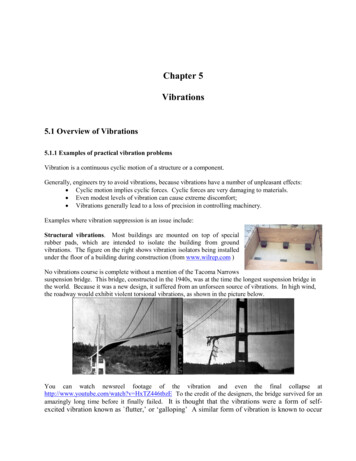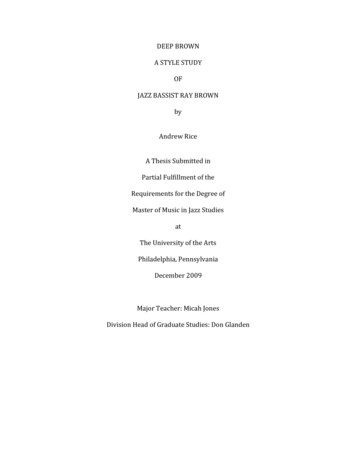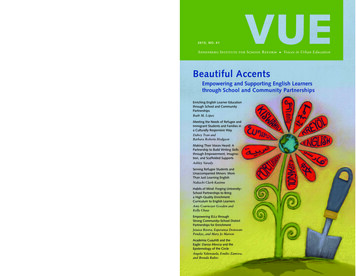
Transcription
Web: http://www.annenberginstitute.orgTwitter: @AnnenbergInstFacebook: https:// Beautiful Accents: Empowering and Supporting English Learners through School and Community PartnershipsAnnenberg Institute for School ReformBrown University, Box 1985Providence, Rhode Island 02912Voices in Urban EducationNon Profit Org.U.S. PostagePAIDProvidence, RIPermit #2022015, NO . 41Annenberg Institute for School Reform Voices in Urban EducationBeautiful AccentsEmpowering and Supporting English Learnersthrough School and Community PartnershipsEnriching English Learner Educationthrough School and CommunityPartnershipsRuth M. LópezMeeting the Needs of Refugee andImmigrant Students and Families ina Culturally Responsive WayDahvy Tran andBarbara Roberts HodgsonMaking Their Voices Heard: APartnership to Build Writing Skillsthrough Empowerment, Imagination, and Scaffolded SupportsAshley VaradyServing Refugee Students andUnaccompanied Minors: MoreThan Just Learning EnglishNakachi Clark-KasimuHabits of Mind: Forging UniversitySchool Partnerships to Bringa High-Quality EnrichmentCurriculum to English LearnersAmy Cournoyer Gooden andKelly ChaseThis book is printed on Environment Paper. This 100 percent recycled paper reducessolid waste disposal and lessens landfill dependency. With this project, the followingresources will be saved:Empowering ELLs throughStrong Community–School DistrictPartnerships for Enrichment 2,341 lbs of wood, which is equivalent to 8 trees that supply enough oxygenfor 4 people annually.Jessica Rivera, Esperanza DonovanPendzic, and Mary Jo Marion 2mln BTUs of energy, which is enough energy to power the average householdfor 10 days. 208 lbs of solid waste, which would fill 46 garbage cans. 710 lbs of emissions, which is the amount of carbon consumed by 8 tree seedlingsgrown for 10 years.2 0 1 5, N O . 4 1 3,419 gallons of water, which is enough for 198 eight-minute showers.Academia Cuauhtli and theEagle: Danza Mexica and theEpistemology of the CircleAngela Valenzuela, Emilio Zamora,and Brenda Rubio
About the Gateway CitiesEducation AgendaThe theme of this issue of VUE is inspired by theSummer English Language Learners EnrichmentAcademies held across twenty Gateway Citiesin Massachusetts – located in formerly thrivingindustrial centers that need resources to addresseconomic declines. As part of the Gateway CitiesEducation Agenda, 3 million in grants wereawarded in 2013 and again in 2014 to address theEnglish language development of immigrant andnewcomer students in summer academies. TheMassachusetts Executive Office of Educationdesigned and managed this grant program. As theexternal evaluator of the enrichment academiesprogram, the Annenberg Institute for SchoolReform observed how community partnershipswere key to the successful implementation of theseacademic programs and how the enrichmentprograms contributed to youth development andempowerment in a number of ways. We asked across-sector group of authors: What role didcommunity partnerships play in supporting thelearning and development of English languagelearners in a culturally responsive way? We definedcommunity partnerships broadly to includenonprofit community organizations, collegesand universities, and families.For more information on the Gateway Cities, About-the-Gateway-Cities.aspx.Beautiful Accents: Empowering andSupporting English Learners throughSchool and Community Partnerships2015, no. 41Executive EditorPhilip GloudemansGuest EditorRuth M. LópezManaging EditorMargaret Balch-GonzalezSenior EditorO’rya Hyde-KellerCopyeditorSheryl KaskowitzProduction and DistributionMary Arkins DecasseDesignBrown University Graphic ServicesIllustratorRobert BrinkerhoffVoices in Urban Education (ISSN 1553541x) is published quarterly at BrownUniversity, Providence, Rhode Island. Articles may be reproduced with appropriatecredit to the Annenberg Institute. Singlecopies are 12.50 each, including postageand handling. A discount is available onbulk orders. Call 401 863-2018 for further information.VUE is available onlineat vue.annenberginstitute.org.The Annenberg Institute for SchoolReform was established in 1993 at BrownUniversity. Its mission is to develop, share,and act on knowledge that improves theconditions and outcomes of schooling inAmerica, especially in urban communitiesand in schools attended by traditionallyunderserved children. For program information, contact:Annenberg Institute for School ReformBrown University, Box 1985Providence, Rhode Island 02912Tel: 401 863-7990Web: http://annenberginstitute.orgTwitter: @AnnenbergInstFacebook: olReform 2015 Brown University, AnnenbergInstitute for School ReformIIAnnenberg Institute for School Reform
Beautiful Accents: Empowering andSupporting English Learners through Schooland Community PartnershipsEnriching English Learner Education through School and Community Partnerships2Ruth M. LópezCommunity partnerships allow schools and districts to empower and engage a broad rangeof English learners and their families in culturally responsive ways to support student learningand socio-emotional development.Meeting the Needs of Refugee and Immigrant Students and Families in a Culturally Responsive Way 7Dahvy Tran and Barbara Roberts HodgsonThrough family engagement and expanded learning time, a partnership between the district anda community organization in Lowell, Massachusetts, serves the social and academic needs ofrefugee youth and other English learners and their families.Making Their Voices Heard: A Partnership to Build Writing Skills through Empowerment,Imagination, and Scaffolded Supports16Ashley VaradyIn San Francisco, a partnership between a K–8 school and a nonprofit writing program helpsstudents who are achieving below grade level find their voices and blossom into confident thinkersand writers.Serving Refugee Students and Unaccompanied Minors: More Than Just Learning English20Nakachi Clark-KasimuA nonprofit in San Francisco partners with area high schools to serve immigrant and refugeestudents, including a growing number of undocumented, unaccompanied minors, who face notonly learning English but also trauma and a host of other issues.Habits of Mind: Forging University-School Partnerships to Bring a High-Quality EnrichmentCurriculum to English Learners26Amy Cournoyer Gooden and Kelly ChaseBoston University and the Malden, Massachusetts, school district worked with the communityto support English learners and develop a curriculum around five “habits of mind.”Empowering ELLs through Strong Community–School District Partnerships for Enrichment36Jessica Rivera, Esperanza Donovan-Pendzic, and Mary Jo MarionA collaboration in Worcester, Massachusetts, between the district, higher education institutions,and community organizations, including a Spanish-language television program, provided culturallyresponsive out-of-school enrichment programs for English learners.Academia Cuauhtli and the Eagle: Danza Mexica and the Epistemology of the CircleAngela Valenzuela, Emilio Zamora, and Brenda RubioAn out-of-school program for fourth-grade English learners in Austin, Texas – jointly developedby the school district, the City of Austin, and a local community group – has co-constructed acurriculum that incorporates the Aztec dance or ceremony Danza Mexica as a core component.46
Enriching English Learner Education throughSchool and Community PartnershipsRuth M. LópezCommunity partnerships allow schools and districts to empower and engage a broad range ofEnglish learners and their families in culturally responsive ways to support student learning andsocio-emotional development.Iwas once an English learner. I am the daughter of immigrants from El Salvadorand México. When I was born, my parents were learning English, and theycommunicated with me in the most natural way they knew – in Spanish. Thiswas not framed as a “problem” until I was enrolled in pre-school. The earliest andmost vivid educational memory I have is of my young mother advocating on mybehalf that my fluency in Spanish did not imply low intelligence and did not justifymy being held back in school. Eventually, she found a school that would teach meEnglish in the age-appropriate grade, but from a young age I was sent the messagein school that my native language was one that needed to be kept in the home.My cultural heritage was rarely reflected in the curriculum I was learning – sorarely that I easily recollect the experiences I most value in my K–12 education: thetime in fifth grade when we created a booklet highlighting natural resources fromdifferent countries, and I glued coffee beans to construction paper, drew coconuttrees to represent El Salvador, and proudly drew the map of my mother’s country;and the time in high school when I read Bless Me, Ultima by Rudolfo Anaya, thefirst book I read by a Mexican-American author, leading to my wanting to readany book by an author with a Spanish surname. Once I was exposed to these waysof learning that reflected my cultural heritage, I became passionate about learningmore about Latino culture and history and pursuing my education beyond highschool, eventually earning my Ph.D. in education.Numerous local and national Latino organizations supported this process for me,but not until later in high school. I think now about how different my earlyeducational experience would have been with more exposure to culturallyresponsive curriculum, including greater ties with community organizations.I share this story to introduce the theme of this issue of VUE: the rich experiencesthat partnerships between districts and community institutions, such as nonprofitsand universities, can provide for children of diverse backgrounds. The theme wasRuth M. López is a senior research associate at the Annenberg Institute for School Reform atBrown University.2Annenberg Institute for School Reform
inspired by the Summer English Language Enrichment Academies held acrosstwenty school districts in Massachusetts. Three of the articles focus on programsthat resulted from this grant, and we also include the perspective of programsserving similar populations of students in California and Texas.This issue focuses on out-of-school programs that engage students who arenewcomers, refugees, immigrants, and children of immigrants, often labeled as“English learners.” The phrase “beautiful accents” in the title refers to the manyinstances that are shared throughout this issue where students’ heritage languagesand cultural backgrounds are seen as an asset rather than simply signaling a lackof English. As one of our contributors, Esperanza Donovan-Pendzic, stated to hersummer program students who admitted feeling their accents held them back,“You cannot be afraid because of your accent. Think of being bilingual andmultilingual as additive. English, Acholi, Swahili, it’s amazing. I admire you.”T H E GATEWAY CITIES INITIATIVE AND THE IMPORTANCEO F C O M M UNI TY PARTNER SHIP SThe Summer Enrichment Academies were part of the Gateway Cities initiative,launched by the Massachusetts Executive Office of Education (EOE) in 2013 underformer governor Deval Patrick. The Gateway Cities were once thriving industrialcenters, but due to economic declines, face the need for more resources andcapacity.1 This lack of resources has an impact on the educational and careeropportunities available to students in these cities. To address the growing needsof these communities, the EOE implemented the Commonwealth of MassachusettsGateway Cities Education Agenda in 2013 with the goal:to close the persistent achievement gaps that disproportionately affect childrenliving in poverty, students of color, students who are English language learnersand students with disabilities, many of whom are heavily concentrated in theCommonwealth’s twenty-six Gateway Cities.2As part of this agenda, the EOE in 2013 and again in 2014 awarded twentyGateway City school districts across Massachusetts a total of 3 million in competitive grants to support intensive summer English language learning for middleand high school immigrant and newcomer students. During the summerof 2014, these academies served nearly 1,700 students. Originally, the summeracademies were to be funded for 2015. However, the 2015 funding was cut aspart of efforts to close a 768 million state budget deficit.Each summer academy was required to have an academic and enrichment component. The programs were allowed to create their own curriculum and chooseformative and summative assessments, and they were encouraged to collaboratewith nonprofit organizations and/or institutions of higher education.The Annenberg Institute for School Reform at Brown University (AISR) served asexternal evaluator of the Gateway Cities grant program. Through mixed-methodsevaluation that included assessment analysis and qualitative findings from six casestudies, we documented the program design, conditions, and outcomes of these sixacademies. We observed that community partnerships were key to the successful1 See ut-the-Gateway-Cities.aspx.2 452/207474/ocn795183245-2014-02-14.pdf?sequence 1.Ruth M. LópezVUE 2015, no. 413
implementation of the academic programs and to positive youth identitydevelopment and empowerment.In four of the six sites we visited, we witnessed strong partnerships with community organizations to develop an engaging, well-rounded, and supportive summeracademy. Although the focus of the Gateway Cities initiative was on Englishlanguage development – and we documented increases in pre- and post-testassessments during the summer for all twenty academies – we also witnessedlearning taking place through culturally responsive teaching, often provided inpartnership with community organizations in the form of enr
Beautiful Accents: Empowering and Supporting English Learners through School and Community Partnerships . to close the persistent achievement gaps that disproportionately affect children living in poverty, students of color, students who are English language learners and students with disabilities, many of whom are heavily concentrated in the Commonwealth’s twenty-six Gateway Cities.2 As .


